
The Sri Lanka frogmouth, Sri Lankan frogmouth or Ceylon frogmouth is a small frogmouth found in the Western Ghats of south India and Sri Lanka. Related to the nightjars, it is nocturnal and is found in forest habitats. The plumage coloration resembles that of dried leaves and the bird roosts quietly on branches, making it difficult to see. Each has a favourite roost that it uses regularly unless disturbed. It has a distinctive call that is usually heard at dawn and dusk. The sexes differ slightly in plumage.
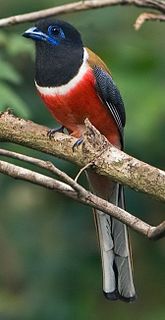
The Malabar trogon is a species of bird in the trogon family. It is found in the forests of Sri Lanka and peninsular India. In India it is mainly found in the Western Ghats, hill forests of central India and in parts of the Eastern Ghats. They are insectivorous and although not migratory, may move seasonally in response to rain in hill forest regions. Like in other trogons, males and females vary in plumage. The birds utter low guttural calls that can be heard only at close quarters and the birds perch still on a branch under the forest canopy, often facing away from the viewer making them easy to miss despite their colourful plumage.

The olive-backed sunbird, also known as the yellow-bellied sunbird, is a species of sunbird found from Southern Asia to Australia.
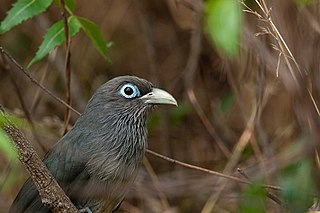
The blue-faced malkoha or small green-billed malkoha, is a non-parasitic cuckoo found in the scrub and deciduous forests of peninsular India and Sri Lanka. It has a waxy, dark, blue-grey plumage on its upperparts and has a long tail with graduated white-tipped feathers. The throat and chin are dark with spiny pale feathers that are branched. The lower belly is a dull creamy to rufous colour. The bill is apple green, and a naked patch of blue skin surrounds the eye. The sexes are alike. The blue-faced malkoha is a bird of open forests and scrub jungle.

The crested treeswift is a species of tree swift. It was for some time considered the same species as its eastern relative, the gray-rumped treeswift, but they do not interbreed where their ranges overlap. It is distinct in flight, with long, bowed wings and a deeply forked tail that usually appears narrow and pointed.

The Sri Lankan junglefowl, also known as the Ceylon junglefowl or Lafayette's junglefowl, is a member of the Galliformes bird order which is endemic to Sri Lanka, where it is the national bird. It is closely related to the red junglefowl, the wild junglefowl from which the chicken was domesticated. However, a whole-genome molecular study rather show that Sri Lankan junglefowl and grey junglefowl are genetically sister species than with the red junglefowl. Sri Lankan junglefowl and red junglefowl diverged about 2.8 million years ago, whereas time of divergence between the Sri Lankan junglefowl and grey junglefowl was 1.8 million years ago.

The purple sunbird is a small bird in the sunbird family found mainly in South and Southeast Asia but extending west into parts of the Arabian peninsula. Like other sunbirds they feed mainly on nectar, although they will also take insects, especially when feeding young. They have a fast and direct flight and can take nectar by hovering like a hummingbird but often perch at the base of flowers. The males can appear all black in harsh sunlight but the purple iridescence is visible on closer observation or under good light conditions. Females are olive above and yellowish below.

The purple-rumped sunbird is a sunbird endemic to the Indian Subcontinent. Like other sunbirds, they are small in size, feeding mainly on nectar but sometimes take insects, particularly when feeding young. They can hover for short durations but usually perch to lap nectar from flowers. They build a hanging pouch nest made up of cobwebs, lichens and plant material. Males are contrastingly coloured but females are olive above and yellow to buff below. Males are easily distinguished from the purple sunbird by the light coloured underside while females can be told apart from females by their whitish throats.

The crimson-backed sunbird or small sunbird is a sunbird endemic to the Western Ghats of India. Like other sunbirds, they feed mainly on nectar although they take insects, especially to feed their young. They are tiny birds that are resident and are found in forests but are particularly attracted to gardens at the edge of the forest where people grow suitable flower-bearing plants. They usually perch while taking nectar.

The variable sunbird or yellow-bellied sunbird, formerly Nectarinia venusta, is a sunbird. The sunbirds are a group of small Old World passerine birds which feed largely on nectar, although they will also take insects, especially when feeding young. Flight is fast and direct on their short wings. Most species can take nectar by hovering like a hummingbird, but usually perch to feed most of the time.

The yellow-browed bulbul, or golden-browed bulbul, is a species of songbird in the bulbul family, Pycnonotidae. It is found in the forests of southern India and Sri Lanka. The yellow-browed bulbul is mainly yellow on the underside and olive above with a distinct yellow brow. They are easily located by their loud calls but tend to skulk within foliage below the forest canopy. While its taxonomic classification has changed over time, it is currently the sole species within the monotypic genus Acritillas which is closely related to Hemixos.

The Indian robin is a species of passarine bird in the family Muscicapidae. It is widespread in the Indian subcontinent and ranges across Bangladesh, Bhutan, India, Nepal, Pakistan and Sri Lanka. The males of the northern subspecies have brown backs whose extent gradually reduces southwards, with the males of the southern subspecies having all-black backs. They are commonly found in open scrub areas and often seen running along the ground or perching on low thorny shrubs and rocks. The long tail is usually held up and the chestnut undertail coverts and dark body make them easily distinguishable from pied bushchats and Oriental magpie-robins.

The bar-winged flycatcher-shrike is a small passerine bird usually placed in the Vangidae. It is found in the forests of tropical southern Asia from the Himalayas and hills of southern India to Indonesia. Mainly insectivorous it is found hunting in the mid-canopy of forests, often joining mixed-species foraging flocks. They perch upright and have a distinctive pattern of black and white, males being more shiny black than the females. In some populations the colour of the back is brownish while others have a dark wash on the underside.

The Seychelles sunbird is a small passerine from the sunbird family. It is named after the French explorer Jean-Jacques Dussumier. It is native to the Seychelles, where it is known as kolibri in Seychellois Creole. This bird is placed in the genus Cinnyris by some authorities and in Nectarinia by others. Although this bird has a limited range, it is described as common and has a stable population, so the International Union for Conservation of Nature has rated its conservation status as being of "least concern".
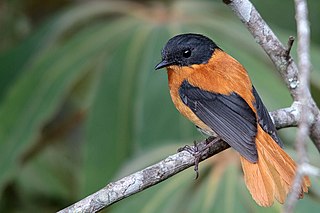
The black-and-orange flycatcher or black-and-rufous flycatcher is a species of flycatcher endemic to the central and southern Western Ghats, the Nilgiris and Palni hill ranges in southern India. It is unique among the Ficedula flycatchers in having rufous coloration on its back and prior to molecular studies was suggested to be related to the chats and thrushes.
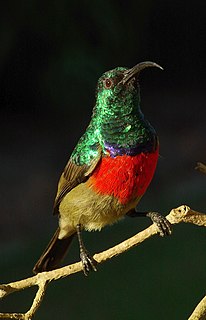
The greater double-collared sunbird, is a small bird in the sunbird family.

The souimanga sunbird is a small passerine bird of the sunbird family, Nectariniidae. It is native to the islands of the western Indian Ocean where it occurs on Madagascar, the Aldabra Group and the Glorioso Islands.
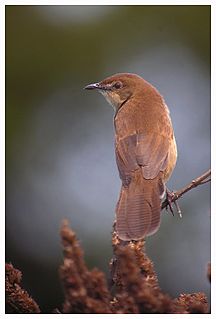
The broad-tailed grassbird is a species of Old World warbler in the family Locustellidae. It is endemic to the Western Ghats of India with a possibility of occurrence in Sri Lanka. A small, mostly brown bird, it has a broad rounded and graduated tail. It is found only on the higher altitude grassy hills where it usually skulks, except during the breeding season when males fly up into the air to sing in their display. The species is believed to be a resident although it is possible that they make local movements.
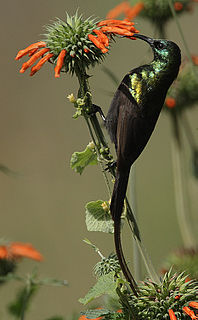
The bronzy sunbird is a species of bird in the family Nectariniidae. They are located mostly in parts of southern Africa.
Hofmann's sunbird is a species of bird in the family Nectariniidae. It is endemic to eastern Tanzania.



























